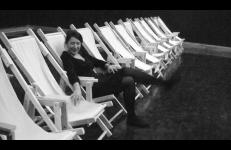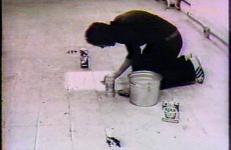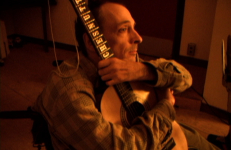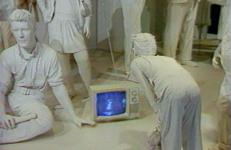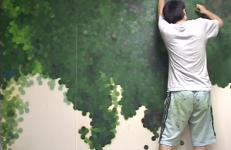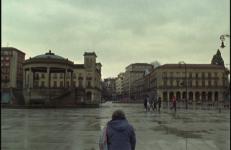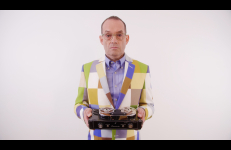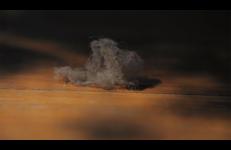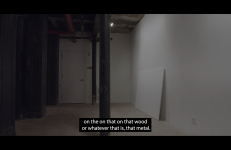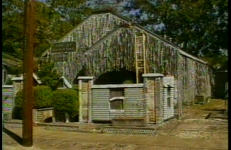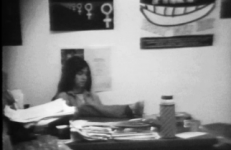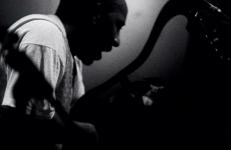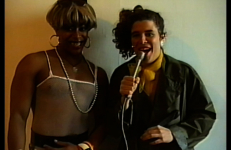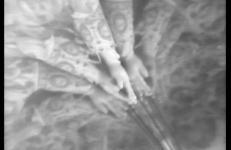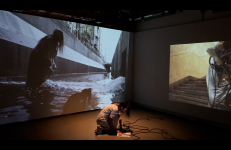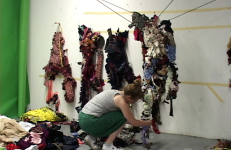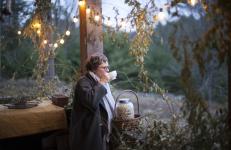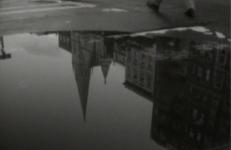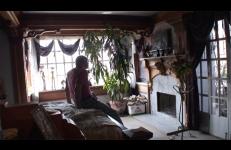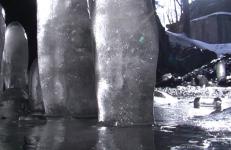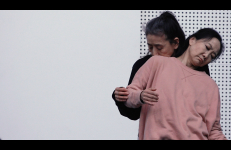Mexican video artist Ximena Cuevas documented the preparations and opening of the Marina Abramovic Videoinstalaciones exhibit at Mexico City's Laboratorio Arte ALameda, the first Abramovic exhibition ever to take place in Mexico, in November of 2008. Cuevas captures the self proclaimed "performance grandmother" in a number of personal and performative moments as she readies for the opening.
Artist Spaces
This video presents a history of alternative spaces in New York City during the late 1960s and early 1970s, focusing on two galleries that no longer exist. The work produced in these two spaces forms the basis of the New Museum of Contemporary Art’s 1981 exhibition Alternatives in Retrospect: An Overview 1969-1975. Curator Jacki Apple, who produced the video, assembled documentation from the galleries and reconstructed artworks for the exhibition.
A musical portrait of Vic Chesnutt and company recording the song, CHAIN.
The piece was shot during the recording session for the album, At the Cut, at the Hotel2Tango studio in Montreal, and features appearances by musicians including Efrim Menuck, Guy Picciotto, Jessica Moss, and Chad Jones. CHAIN was written by Chesnutt after viewing Cohen's feature film of that name.
Commissioned by the Oakland Museum, this video provides an artist’s interpretation of the museum’s displays and collections. The voice of a friendly narrator enlarges the image-objects with historical and social information, while a written text provides ironic commentary. “The term curator is derived from the Latin ‘curatus’ —one responsible for the care of souls.” The daughter represented in the famous Dorthea Lange photograph of the Migrant Mother recounts the circumstance surrounding the now-celebrated photograph and how it impacted her life.
Satoshi Uchiumi, Japanese abstract painter, believes that the beauty of painting lies within paint itself. He has pursued beauty by painting thousands of colored dots. He has also become known for his ability to highlight the relationship between the artwork, the exhibition space, and the viewer.
Uncomfortable journeys through the work and ideas of Christopher Cozier, a leading contemporary artist in the Caribbean. The video presents Cozier's witty and incisive drawings, installations and videos in the context of post-independence Trinidad with its oil-rich economy, complicated ethnic politics, and vibrant cultural forms.
A portrait of Luce Vigo, film critic, educator, and the daughter of pivotal French filmmaker Jean Vigo. Commissioned by the Spanish documentary festival, Punto de Vista, the film incorporates Luce's memories of her extraordinary life, reflections on her father, and images of Northern Spain.
Don’t You Like the Green of A? is based on the correspondences between letters and colors specific to Joan Mitchell’s synesthesia––a condition that Henricks happens to share with her. Synesthesia is a neurological syndrome in which perception by one sense automatically triggers a perception in one of the other senses. This connectivity between senses may be manifested in different ways. For example, in grapheme-colour synaesthesia, numbers or letters are associated with colors; in music-color synesthesia, people perceive color by hearing a sound or music.
A domestic portrait rendered at miniature scale, Dust Studies brushes along the edge of what can be seen. Staying close to the ground to collect what gathers there, the film looks deeply for everyday things and finds them drifting in the pleasant, meandering headwaters of a young child's language.
Note: This title is intended by the artist to be viewed in High Definition. While DVD format is available to enable accessibility, VDB recommends presentation on Blu-ray or HD digital file.
Framing the solo exhibition Prophetic Memory, this video remediates images of the NYC nonprofit art gallery, Artists Space, with the filmmaker’s grandmother's descriptions of how she would use her interior design skills to design their exhibition. Because she couldn’t travel there because of disability and the risks posed by the Covid-19 pandemic (even as this show occurred during the first wave of NYC art spaces “returning to normal"), she relies on the images she’s watching and describing to visualize her ideas.
A house covered with beer cans, a tribute to the orange; Eyeopeners features seven Houston, Texas, folk art environments, eye-opening creations that are monuments to the wonders of ingenuity and imagination. Expressions of profound instincts and powerful urges, the Eyeopeners sites remind us of the unselfconscious heights of expression that self-taught artists can attain. The video features the artists on-camera talking about these personal journeys and the forces that motivate their wo
In 1975, the Feminist Studio Workshop (I was a member) at the Woman’s Building in LA, the Women’s Interart Center in New York City, and another feminist organization in Washington DC, attempted to set up a video exchange among feminist art organizations. This was the first videoletter on our end. I don’t know if another one was ever made.
The videoletter is a tour of the Woman’s Building. Pam McDonald, with microphone in hand, another workshop member, and myself, served as guides through the building. It was shot with a black and white video portopack.
A reflection on the phenomenon of the touring musician.
"I shot this film with a 16mm wind-up Bolex, and the 25th Anniversary tour of Dutch band The Ex, when they embarked on a 'convey tour' with about 25 performing comrades. If half the battle is getting there and half the battle is joy, then the other half is madness. I thank all of the musicians who float in and out — of the film, in particular, and my life, in general."
— Jem Cohen
Soundtrack music: Guitargument, an Andy Moor and Mia Clarke improvisation, arranged and edited by Jem Cohen.
Hokey Sapp Does SPEW features Kate Schechter performing her invented media personality Hokey Sapp interviewing some of the luminaries at SPEW: The Homographic Convergence, a queer zine convention hosted by Randolph Street Gallery in Chicago in May, 1991. SPEW brought together artists, writers, editors of zines, performers, video-makers, activists, and bands from throughout the US and Canada, and marked the explosion of queercore subcultures through unabashed fashion, outrageous politics, humor, and joy.
Freed experiments with kaleidoscopic imagery while capturing images of children and herself around the home. Utilizing an infinity mirror, she creates numerous reflections of arms, legs, faces as well as other body parts and points the camera through a translucent surface to further this reflective aesthetic. Amongst intimate self portraits, Freed occasionally turns control of the camera over to the children which results in playful switching between video signals and switching lights on and off erratically.
Eiko Otake’s I Invited Myself is a multi-volume installation which features choreography of place, movements of both performer and viewers, along with projections of selected video and film works created by Eiko over the last 40 years.
Unlike audiences to cinema, literature, music, and visual art works, the audience to contemporary performance work often experiences one newly created evening-length piece. Those audiences who saw the artist’s earlier works have an understanding of her trajectory, but younger or new audiences might not.
This film observes six art students working in their studios in parallel. It offers a rare glimpse into the inside of art school studios.
J. Morgan Puett is an internationally renowned artist living on a 95-acre compound in the deciduous forests of northeastern Pennsylvania. Touching on ideas of creative domestication, radical pedagogy, and a critical engagement with one’s environment, Ms. Puett describes her unique home, which she calls Mildred’s Lane.
“It (J. Morgan Puett: A Practice of Be(e)ing) tells a unique story of an important artist that truly lives her art. It’s an exclusive biography of a woman who is widely known to the art world but, as yet, undiscovered by our culture.”
—Roderick Angle
In this interview, Phyllis Kornfeld, author of Cellblock Visions: Prison Art in America, describes her initial interest in working with prisoners in her native Oklahoma City, stemmed from an exploration of outsider artists. Detailing her first visit to a high security prison as a ‘mind blowing and breathtaking’ experience, Kornfeld discusses how she came to her realization that prisons are fertile environments for free form experimentation with the teaching process. She learned that through personalized art education, inmates could teach themselves to make positive contributions to society. - Kyle Riley
Long for the City is a short portrait of Patti Smith in the city where she lives. Patti recites the very first poem-song she ever wrote, and then a later one, "Prayer", from the early 1970s. We take a walk in her changing neighborhood, and I ask her what she saw. Footage was shot in the moment, as well as drawn from the archive I've gathered over many years. Long for the City can be considered a non-musical companion piece to the music short, Spirit, which we collaborated on in 2007.
The viewer is whisked through a lovely cat-house, which also includes a turtle along with the whiskered pets, and then is suddenly immersed in the painted output of my old (yet still young and vibrant looking) friend, Michelle Joyce. We follow this cheerful personage on a tour of her studio and then get transported to a high-class arts center in midtown Frisco where the work is displayed to a variety of yapping youth in yo-yo mode.
A five-minute video collaboration between Dani Leventhal and Steve Reinke.
A five-minute video collaboration between Dani Leventhal and Steve Reinke.
This is a story of friendship between two independent female artists and their body memories each willingly carry. In January 2020, New York based, interdisciplinary performing artist Eiko Otake arrived in Beijing to visit Wen Hui, a Chinese choreographer and filmmaker. Eight years apart, Eiko grew up in postwar Japan and Wen during the Cultural Revolution. They planned to visit each other for a month to converse and collaborate. The surge of COVID-19 abruptly cut off Eiko's visit and the pandemic has made Wen's visit to the USA impossible but the collaboration continued.




